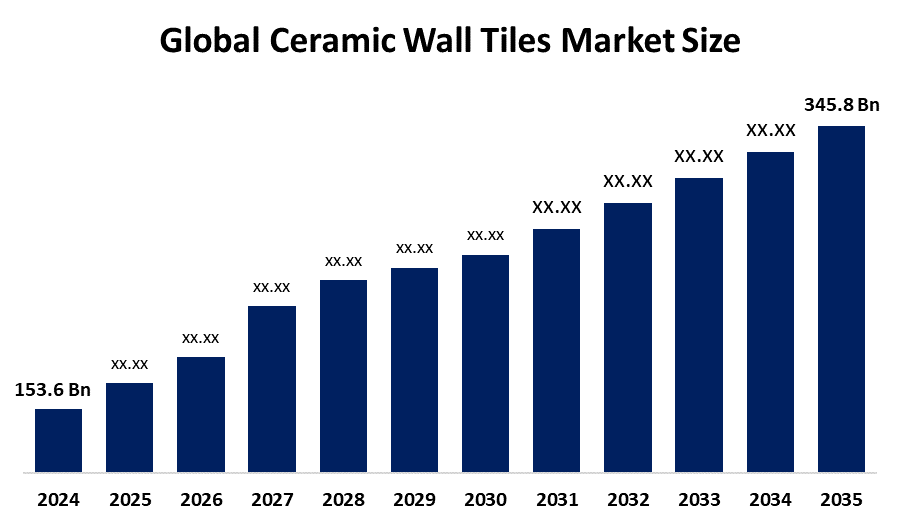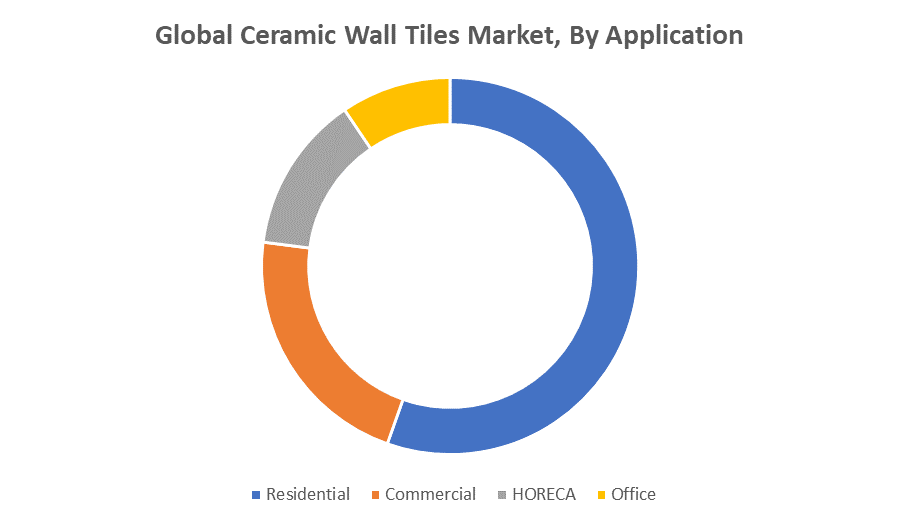Global Ceramic Wall Tiles Market Insights Forecasts to 2035
- The Global Ceramic Wall Tiles Market Size Was Estimated at USD 153.6 Billion in 2024
- The Market Size is Expected to Grow at a CAGR of around 7.66% from 2025 to 2035
- The Worldwide Ceramic Wall Tiles Market Size is Expected to Reach USD 345.8 Billion by 2035
- Middle East & Africa is expected to grow the fastest during the forecast period.

Ceramic Wall Tiles Market
The Global Ceramic Wall Tiles Market Size refers to the industry involved in the manufacturing, distribution, and sale of ceramic tiles designed specifically for wall applications. These tiles are made from natural clay, minerals, and other raw materials, and are fired at high temperatures to create durable, moisture-resistant surfaces. Ceramic wall tiles are widely used in residential, commercial, and industrial buildings due to their aesthetic appeal, ease of maintenance, and versatility. They are available in various designs, colors, and sizes, and are commonly applied in bathrooms, kitchens, and living areas. The market is influenced by factors such as urbanization, rising construction activities, and consumer preferences for modern, sustainable materials. Additionally, advancements in manufacturing technologies and growing demand for eco-friendly products are contributing to the growth of the ceramic wall tiles market globally. It is expected to continue expanding with innovations in design and increased construction projects worldwide.
Attractive Opportunities in the Ceramic Wall Tiles Market
- The Asia-Pacific and Middle East & Africa regions are experiencing rapid urbanization and construction growth. These regions present significant growth opportunities due to increasing demand for both residential and commercial buildings. Manufacturers can tap into these markets by offering cost-effective, high-quality ceramic tiles tailored to local preferences. Additionally, partnerships with regional architects, interior designers, and real estate developers could facilitate entry into the market with customized solutions for emerging urban spaces.
- The growing trend of smart homes presents a unique opportunity for ceramic tile manufacturers. Tiles that integrate heated systems, sensors, or LED lighting could become highly desirable in the residential and commercial markets. For instance, heated tiles or tiles with embedded sensors that monitor humidity or temperature could appeal to tech-savvy homeowners and businesses looking for functionality in their interior design. This could open new revenue streams and cater to the premium market.
Global Ceramic Wall Tiles Market Dynamics
DRIVER: Rising disposable incomes and changing consumer preferences
The rapid urbanization and increasing demand for residential and commercial buildings are significant contributors. As cities expand and new infrastructure projects emerge, the need for durable, attractive materials like ceramic wall tiles rises. Second, the rising disposable incomes and changing consumer preferences for aesthetic appeal and quality materials are also driving demand. People are increasingly opting for stylish, low-maintenance ceramic tiles that offer both functionality and design versatility. Third, advancements in manufacturing technologies have made ceramic tiles more affordable, while innovations like larger sizes, eco-friendly options, and improved durability are attracting more consumers. Fourth, the growing emphasis on sustainability and environmentally friendly products is encouraging manufacturers to develop eco-conscious tiles, further boosting the market. Lastly, the increasing popularity of home improvement and renovation projects globally also fuels demand for ceramic wall tiles.
RESTRAINT: Energy-intensive manufacturing process of ceramic tiles
One major challenge is the fluctuating prices of raw materials, such as clay, quartz, and minerals, which can lead to increased production costs. This can make ceramic tiles more expensive for consumers, limiting their accessibility, especially in price-sensitive markets. Additionally, the growing popularity of alternative materials like vinyl, glass, and digital prints, which can mimic the look of ceramic tiles at lower costs, poses competition to the market. Another restraint is the energy-intensive manufacturing process of ceramic tiles, which not only increases costs but also raises environmental concerns regarding carbon emissions. Furthermore, the availability of low-cost, unbranded ceramic tiles in some regions leads to market fragmentation and price wars, reducing profit margins for established manufacturers. Lastly, fluctuating demand in construction and renovation activities, driven by economic cycles, can create periods of market instability.
OPPORTUNITY: Manufacturers can explore the use of recycled materials
The global ceramic wall tiles market presents several unique opportunities beyond the typical driving factors. One such opportunity is the growing trend of smart homes, where integrated technologies such as heated tiles or tiles with embedded sensors are gaining traction. As consumers demand more functionality from their living spaces, the integration of technology into ceramic tiles could open new revenue streams. Another opportunity lies in the burgeoning demand for sustainable and eco-friendly products. Manufacturers can explore the use of recycled materials, low-emission firing technologies, and water-saving designs to appeal to environmentally conscious consumers. Additionally, expanding into emerging markets, particularly in Asia-Pacific, Africa, and Latin America, presents a significant growth opportunity due to rapid urbanization and increasing construction activities. Collaborations between tile manufacturers and interior designers or architects could also create custom solutions for high-end residential and commercial projects, offering a premium niche market. Lastly, focusing on product innovation with new textures, finishes, and designs can help cater to diverse consumer preferences.
CHALLENGES: Intense competition within the industry
One key challenge is the intense competition within the industry, with a growing number of manufacturers and suppliers entering the market. This leads to price pressures and the need for constant innovation to differentiate products. Another challenge is the long production cycle involved in manufacturing ceramic tiles, which requires significant time and investment in design, raw material sourcing, and quality control. This can lead to delays and inefficiencies, particularly when responding to rapid changes in market demand. Additionally, the complexity of distribution networks and logistics can pose problems, especially when dealing with fragile products like tiles, which require careful handling and transportation. Regulatory challenges also exist, particularly with regard to environmental regulations and standards for tile manufacturing. Adapting to these evolving compliance requirements can add complexity and costs to production. Lastly, the ongoing labor shortages in certain regions affect manufacturing capacity and operational efficiency.
Global Ceramic Wall Tiles Market Ecosystem Analysis
The global ceramic wall tiles market ecosystem includes raw material suppliers, manufacturers, distributors, retailers, consumers, and installers. Raw materials like clay and minerals are sourced by suppliers, while manufacturers produce the tiles using advanced technologies. Distributors and retailers bridge the gap between producers and end users, including homeowners, contractors, and designers. Technological innovation and sustainability trends, such as eco-friendly materials and energy-efficient production, are key drivers. Regulatory bodies ensure compliance with safety and environmental standards, shaping market dynamics and opportunities.
Based on the dimensions, the 30 * 60-dimension segment accounted for the leading revenue share over the forecast period

The 30x60 cm dimension segment is expected to dominate the global ceramic wall tiles market, holding the largest revenue share over the forecast period. This size is highly preferred for its versatility, making it ideal for a wide range of applications, from residential bathrooms and kitchens to commercial spaces. The 30x60 cm tiles offer a balance between functionality and aesthetic appeal, with their rectangular shape allowing for efficient installation and a sleek, modern look. Additionally, their adaptability in design, ease of maintenance, and cost-effectiveness make them a popular choice among consumers and builders, further contributing to their market leadership. As demand for stylish yet practical solutions increase, the 30x60 cm tiles are expected to continue dominating the market.
Based on the application, the residential segment accounted for the major revenue share of the global ceramic wall tiles market during the forecast period

The residential segment is expected to account for the major revenue share of the global ceramic wall tiles market during the forecast period. This is primarily driven by the increasing demand for home renovation and new construction projects. Ceramic wall tiles are a preferred choice for residential spaces such as bathrooms, kitchens, and living rooms due to their durability, water resistance, and aesthetic appeal. Moreover, homeowners are increasingly investing in stylish, low-maintenance materials to enhance the design and functionality of their living spaces. The growing trend of modern home designs, coupled with a rise in disposable incomes, is further fueling demand for ceramic tiles in residential applications. As a result, this segment is anticipated to maintain its dominant position in the market, driven by continuous innovation in tile designs and finishes, catering to diverse consumer preferences.
Asia Pacific is anticipated to hold the largest market share of the ceramic wall tiles market during the forecast period
Asia Pacific is anticipated to hold the largest market share of the global ceramic wall tiles market during the forecast period. This region’s dominance is driven by rapid urbanization, increasing construction activities, and rising disposable incomes, particularly in emerging economies like China, India, and Southeast Asia. The growing demand for residential, commercial, and industrial buildings, along with a preference for high-quality, durable materials, significantly boosts the adoption of ceramic wall tiles. Additionally, the region's large-scale production capabilities, cost-effective manufacturing, and wide variety of designs contribute to its market leadership. The expanding middle class in Asia Pacific, coupled with a surge in home renovations and interior design trends, further supports the growth of the ceramic wall tiles market. With ongoing infrastructure projects and an increasing focus on modern, eco-friendly materials, Asia Pacific is poised to maintain its dominant position in the global market.
Middle East & Africa is expected to grow at the fastest CAGR in the ceramic wall tiles market during the forecast period
The Middle East & Africa (MEA) region is expected to grow at the fastest CAGR in the ceramic wall tiles market during the forecast period. This growth can be attributed to rapid infrastructure development, urbanization, and an increase in construction activities, particularly in countries like the UAE, Saudi Arabia, and South Africa. As demand for residential, commercial, and hospitality projects rises, the need for durable and aesthetically pleasing ceramic wall tiles has surged. Moreover, the region is seeing a shift toward modern interior designs, with homeowners and businesses opting for stylish, easy-to-maintain tiles for their spaces. Government investments in infrastructure and real estate, along with a growing focus on high-quality, sustainable building materials, are also driving this growth. The region's expanding middle class and evolving consumer preferences further support the high demand for ceramic wall tiles, positioning the MEA region for the fastest market expansion during the forecast period.
Recent Development
- In March 2023, Marazzi, a global leader in ceramic tiles, launched a new line of digital ceramic tiles. This range uses advanced printing technology to replicate textures of natural stone and wood. The collection aims to provide a more customizable, high-quality product, responding to the growing demand for intricate designs in residential and commercial applications.
- In July 2023, Kajaria Ceramics, a prominent Indian tile manufacturer, launched a new range of ceramic wall tiles in various sizes, textures, and colors. This series is designed specifically for modern homes, focusing on durability, ease of installation, and aesthetic appeal. The tiles cater to both functional and decorative needs, offering flexibility for different design preferences.
Key Market Players
KEY PLAYERS IN THE CERAMIC WALL TILES MARKET INCLUDE
- Kajaria Ceramics Limited
- LIXIL Group Corporation
- Mohawk Industries, Inc.
- Ceramiche Atlas Concorde
- Roca Group
- Marazzi Group
- Porcelanosa Grupo
- Group Ceramiche Ricchetti S.p.A.
- Somany Ceramics Ltd.
- RAK Ceramics
- Others
Market Segment
This study forecasts revenue at global, regional, and country levels from 2020 to 2035. Spherical Insights has segmented the ceramic wall tiles market based on the below-mentioned segments:
Global Ceramic Wall Tiles Market, By Dimensions
Global Ceramic Wall Tiles Market, By Application
- Residential
- Commercial
- HORECA
- Office
Global Ceramic Wall Tiles Market, By Regional Analysis
- North America
- Europe
- Germany
- UK
- France
- Italy
- Spain
- Russia
- Rest of Europe
- Asia Pacific
- China
- Japan
- India
- South Korea
- Australia






